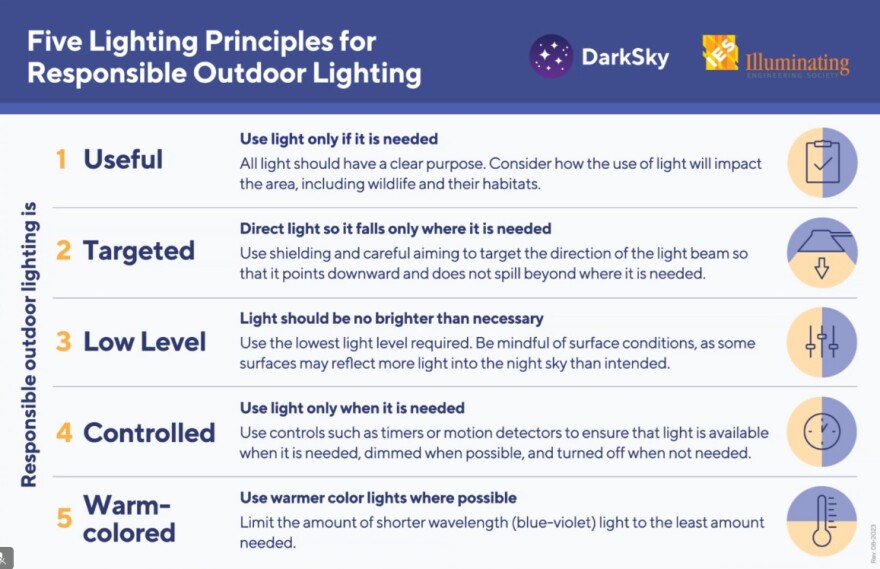BETHLEHEM, Pa. — Thirty years ago, there was an open secret among astronomers on the East Coast: If you wanted a view of the night sky, clear of light pollution, go to Pennsylvania's Cherry Springs State Park.
“Once it became known to [the Department of Conservation and Natural Resources], they started to adapt the park and really support that goal of having a dark sky that people could see,” Steve Werner, environmental educator at Cherry Springs, in Potter County.
“And now, we also have educational programs for visitors where they can experience that dark night sky and also learn about the science and the myths behind it.”
Werner was among the speakers Friday during Commonwealth Sustainability Week’s final virtual panel, “Lights Out — Protecting Wildlife and Ecosystems through Smarter Lighting.”
More than 130 people attended the panel, which focused on efforts across the state to tamp down on light pollution, not only to benefit star-gazers, but for fireflies and migrating birds, too.
“We're reviewing external lighting and identifying opportunities to reduce or eliminate light impacts with the goal to protect migrating wildlife, dark sky viewing and reduce energy.”Ali Bowling, DCNR’s executive policy specialist and panel moderator
In its fifth year, the week, which included webinars and panels each day on sustainability topics, is sponsored by the Pennsylvania GreenGov Council and Penn State Sustainability.
The DCNR “is committed to Lights Out, so we are advancing a Lights Out program across our state park and forest system,” Ali Bowling, DCNR’s executive policy specialist and panel moderator, said.
“We're reviewing external lighting and identifying opportunities to reduce or eliminate light impacts with the goal to protect migrating wildlife, dark sky viewing and reduce energy.”
‘An equal part of the same entity’
Light at night has consequences for all living organisms — including people, Mark Grosz, president of DarkSky International, said.
“Just like light at the wrong time can disrupt our circadian systems, so can it extend into multiple species and affect a whole ecosystem as if it was an entity or individual,” Grosz said.
“So just like our circadian rhythm can be disrupted by light at night, there's a de-circularization of nature going on and that creates all kinds of problems, mistiming of food, timings of migrations.”
And it doesn’t take much light at all to cause a disturbance in those rhythms, he said — any light more than what comes from a full moon is too much.
"It's an unnatural substance released into the natural environment, and it has a growing number of known consequences — it degrades and destroys a nocturnal habitat, and when you consider that two thirds of the creatures on earth are nocturnal, it becomes a big deal."Mark Grosz, president of DarkSky International
“The diurnal and nocturnal work together to create a more resilient, healthy and productive ecosystem,” he said.
“So we can figure all artificial light at night, whether it is valuable to humans or not, is a pollutant.
"It's an unnatural substance released into the natural environment, and it has a growing number of known consequences — it degrades and destroys a nocturnal habitat, and when you consider that two thirds of the creatures on earth are nocturnal, it becomes a big deal.”
Moreover, research has shown pollutants can be synergistic, amplifying the effects of one another.
Air pollution can make sky glow, the brightening of the sky from light pollutants, worse, he said. At the same time, light pollution can actually tear apart other pollutant particles and can exacerbate them.
However, conservation work also can be synergistic, he said.
DarkSky International and the Illuminating Engineering Society came up with five lighting principles for responsible outdoor lighting.
They include that it should be useful, targeted, low level, controlled and warm-colored.

“Both day and the night need to be there to protect the daytime environment,” he said.
“The nighttime environment has to be protected and preserved. They are an equal part of the same entity, which we are a part of.”
Easton’s Environmental Advisory Committee is working to be the first city in the Lehigh Valley to craft and pass a dark skies ordinance.
Migrating birds
Light pollution from cities often can attract migrating birds looking for a place to rest between legs of their journey south.
“Researchers have told us that the illuminated landscapes of our cities and suburbs act as an ecological trap that increases the mortality of birds during migration,” Leigh Altadonna, president emeritus of the Liberty Bird Alliance, said.
“When they settle out in the morning to feed and refuel, they're trying to find green spaces, but they find themselves often in the middle of urban environments where buildings and glass and feral cats and other predators abound, and it has made it a more dangerous situation for migrating birds.”
In early October 2020, there was a mass bird mortality event in Philadelphia, he said. An estimated 1,000 mitigating birds died.
“The birds were flying lower than usual,” he said. “It was a low cloud ceiling, bad weather.
“But they were migrating and then the next morning, they hit the buildings. And, you know, they're in the canyons of the skyscrapers in Center City, Philadelphia, and it led to this mass event.”
Seeing the deaths of so many birds triggered advocates and volunteers to launch Bird Safe Philly, a group focused on dimming city lights during spring and fall migrations and monitoring bird collisions in order to mitigate them.
Window strikes are a known cause of bird deaths. The Valley’s Daniel Klem, director of the Acopian Center for Ornithology at Muhlenberg College, last year published a study finding an estimated 3.5 million birds die every day.
And fall migration is underway. On just Thursday night, an estimated 1.2 million birds crossed the Lehigh Valley, 646,900 over Northampton County and 585,700 over Lehigh County, according to BirdCast, part of the Cornell Lab of Ornithology.
‘For wildlife and future generations’
Similarly, light pollution also can inhibit insects, particularly fireflies, Peggy Butler, founder of the Pennsylvania Firefly Festival, said.
“They don't migrate like birds, but we have to be careful of how we manage our properties with the lighting,” Butler said.
“We grew to learn that the world is seeing a lot of decline in fireflies, and it won't surprise you that it's the lighting that might be contributing to that.”
Habitat loss, as well as light pollution, are threatening the flashy insects.
“There's really nothing more impactful and easy than simply turning off the lights completely,” she said.
“And if you can't turn them off, maybe put them on a timer or motion detectors so that it limits the time that any one habitat is being affected by the lights.”
A small change, such as replacing standard lights with motion-sensors, can make a big difference, Werner said.
“We've started to find out through studies that motion-sensing lights are actually more effective for security,” he said.
“Because, if you think about it, if you're up to no good going through a yard where you shouldn't be, if that light’s on and you're entering that yard, that light hasn't stopped you.
“But, in our animal instincts, if a light is turned on when we enter that yard, it can instill that flight response, where ‘I've been noticed, I've been spotted, I should get out of here.’
"So we can get away with not using any light if we're not outside, and use motion sensing lights for security.”
Small actions can add up, just like the grassroots movement of astronomers flocking to Cherry Springs State Park, he said.
“Small actions eventually led to thousands of people being influenced by Cherry Springs over the years,” he said.
“So all the things we talked about with Lights Out, it could sound like big initiatives, and what can I do to help, [what] is going to make a difference?
“It starts out small, just like Cherry Springs — never a DarkSky park and now is recognized as an International Dark Sky Park after 25 years of including people, visitors and serious astronomers at Cherry Springs.
“It's something we like to do — protect that night sky and can preserve a natural resource for wildlife and future generations.”


